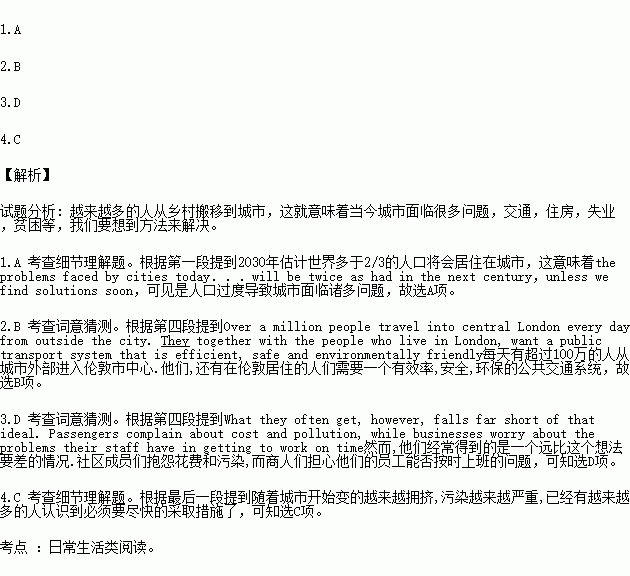题目内容
At no time in history has there been such a mass movement of people from the countryside to the city as is happening now. By the year 2030, it’s estimated that more than two thirds of the world’s population will be living in cities, twice as many as today. This means that the problems faced by cities today—overcrowding, poor housing, unemployment, poverty and lack of food and water—will be twice as bad unless we find solutions soon.
Another serious issue is how to provide good transportation for their citizens. Many of the world’s major cities are already struggling with out-of-date transport infrastructures(基本设施).How can they deal with the additional demands?
London is a good example. Its enlargement was made possible by the invention of the steam engine, which powered the world’s first underground railway. But its transport system are now hopelessly out-of-date and need urgent modernization. London’s future success depends very much on developing better public transport.
Over a million people travel into central London every day from outside the city. They together with the people who live in London, want a public transport system that is efficient, safe and environmentally friendly. What they often get, however, falls far short of that ideal. Passengers complain about cost and pollution, while businesses worry about the problems their staff have in getting to work on time. Yes, the proportion of London households that own a car grew from just over ten percent in the early 1950s to over sixty percent today.
As the city has become increasingly crowded and polluted, there has been a growing realization that action must be taken soon.
1.It is believed that____.
A. overpopulation causes the problem in cities
B. two thirds of the world’s population are living in cities today
C. it isn’t difficult to solve the problem faced by cities today
D. with fewer people we would be free from problems
2.The underlined word “they” in the fourth paragraph refers to _______.
A. the citizens in the city of London
B.those who come to London from other places
C. passengers who make complaints about the cost
D. businesses who are anxious about their staff getting to work late
3.The underlined words “environmentally friendly” is closest in meaning to ________.
A. pleasant and nonpolluting B. cheap and punctual
C. quick and straight D. fair and convenient
4. The following paragraph of this text would most probably deal with___
A. train and air travel
B. traffic jams in London
C. possible solution to London’s transportation problems
D. car ownership that continues to grow.

